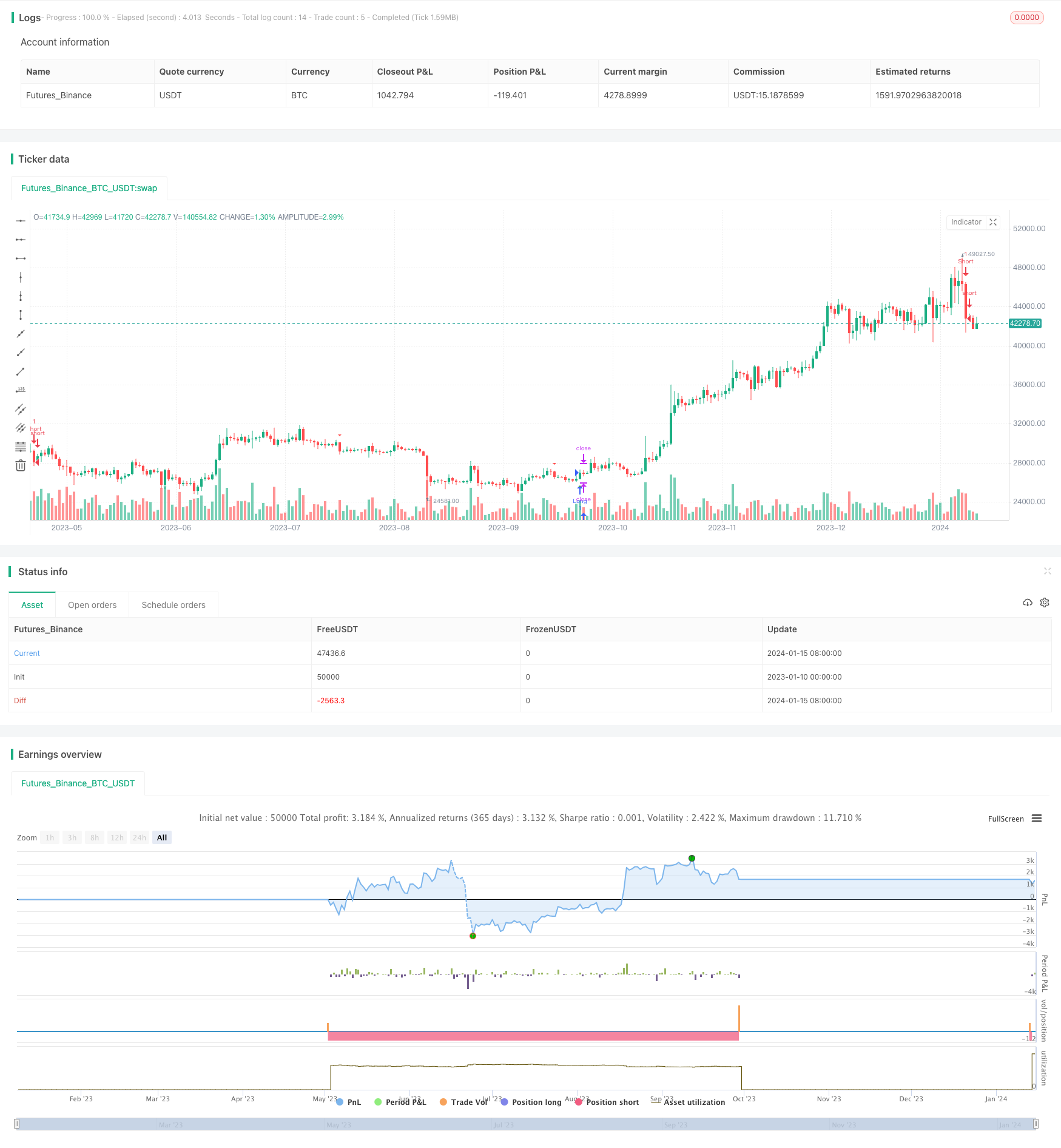Dual SMA Momentum Strategy
Author: ChaoZhang, Date: 2024-01-17 15:05:08Tags:

Overview
The Dual SMA Momentum strategy is a technical analysis based trading strategy that generates buy and sell signals based on two simple moving average (SMA) indicators. It aims to capture short- to medium-term price momentum in a stock.
Strategy Logic
The strategy uses two SMA indicators with short and long time windows - a fast SMA (length 9 periods) and a slow SMA (length 45 periods).
It generates a long/buy signal when the stock’s closing price crosses above both the fast and slow SMA lines, indicating the start of an uptrend. The strategy enters long positions here.
It generates a short/sell signal when the price crosses below both SMA lines, indicating the start of a downtrend. The strategy enters short positions here.
The stop loss levels are set dynamically at the previous day’s high (for short trades) and previous day’s low (for long trades).
Advantage Analysis
The main advantages of this strategy are:
- Uses a combination of short and long term SMAs to capture emerging mid-term trends
- Adaptive stop loss placement reduces risk and lets profits run
- Easy to understand and implement
- Performs well across stocks and markets during trending conditions
However, like all technical analysis strategies, it can underperform during range-bound and whipsaw markets with frequent false signals. An enhancement could be to add other indicators like RSI for additional confirmation.
Risk Analysis
The main risks of this strategy are:
-
Prone to whipsaws and false signals: Since it relies solely on SMA crossovers, the strategy can face whipsaws and false signals during sideways or choppy markets, creating unnecessary trading costs. This can be mitigated by combining with other indicators like RSI.
-
Vulnerable to sudden trend reversals: Swift reversals after SMA crossover entries can hit stop loss levels quickly before a trend forms. This risk can be reduced by optimizing SMA lengths or adding other filters.
-
Overoptimization risk from parameter tweaking: Extensive optimization of the SMA lengths and other parameters to curve fit historical data can lead to poor performance in live trading. Robust backtesting over long time frames is essential.
Enhancement Opportunities
Some ways in which this strategy can be enhanced are:
-
Adding other indicators like RSI for additional trade confirmation to improve timing and accuracy of signals
-
Incorporating dynamic stop loss placement methods like ATR or chandelier exits to better adapt to market volatility
-
Optimizing SMA lengths based on historical volatility and trading time frames for different stocks
-
Adding sound money management and position sizing rules to maximize returns and limit drawdowns
Conclusion
In summary, the Dual SMA Momentum strategy offers a straightforward approach to trade short- to medium-term trends. While basic in its approach, refinements like additional filters, dynamic stops and prudent optimizations can aid in improving its risk-adjusted returns. Used selectively during stock uptrends and downtrends, it can capture profitable moves.
/*backtest
start: 2023-01-10 00:00:00
end: 2024-01-16 00:00:00
period: 1d
basePeriod: 1h
exchanges: [{"eid":"Futures_Binance","currency":"BTC_USDT"}]
*/
//@version=5
strategy("SMA Crossover Strategy", overlay=true)
// Input parameters
fast_length = input(9, title="Fast SMA Length")
slow_length = input(45, title="Slow SMA Length")
// Calculate moving averages
fast_sma = ta.sma(close, fast_length)
slow_sma = ta.sma(close, slow_length)
// Buy condition
buy_condition = ta.crossover(close, fast_sma) and ta.crossover(close, slow_sma)
// Sell condition
sell_condition = ta.crossunder(close, fast_sma) and ta.crossunder(close, slow_sma)
// Calculate stop loss levels
prev_low = request.security(syminfo.tickerid, "1D", low[1], lookahead=barmerge.lookahead_on)
prev_high = request.security(syminfo.tickerid, "1D", high[1], lookahead=barmerge.lookahead_on)
// Plot signals on the chart
plotshape(buy_condition, style=shape.triangleup, location=location.belowbar, color=color.green, size=size.small)
plotshape(sell_condition, style=shape.triangledown, location=location.abovebar, color=color.red, size=size.small)
// Strategy exit conditions
long_stop_loss = sell_condition ? prev_low : na
short_stop_loss = buy_condition ? prev_high : na
strategy.exit("Long Exit", from_entry="Long", when=sell_condition, stop=long_stop_loss)
strategy.exit("Short Exit", from_entry="Short", when=buy_condition, stop=short_stop_loss)
strategy.entry("Long", strategy.long, when=buy_condition)
strategy.entry("Short", strategy.short, when=sell_condition)
- Breakthrough of Daily High-low Price Based on Fibonacci Levels
- Improved SuperTrend Strategy
- Quantitative Trading Strategy Integrating MACD, RSI and RVOL
- Momentum Inversion Tracking Strategy
- Trend Following Strategy Based on EMA and SMA Crossover
- Simple Pivot Reversal Algorithmic Trading Strategy
- Adaptive Trading Strategy Based on ADX Indicator
- Dynamic Channel Breakout Strategy
- Multi-filter Bollinger Band Trading Strategy
- True Range Based Weighted Moving Average Cross Period Strategy
- Momentum Mean Deviation Breakthrough Strategy
- Bollinger Bands Based Intelligent Tracking Trading Strategy
- Multifactor-Driven Trend Trading Strategy
- Momentum Breakout Strategy
- RSI Indicator Based Moving Stop Loss Buy Sell Strategy
- Extreme Short-term Scalping Strategy
- Optimized EMA Crossover Strategy
- MA Turning Point Long and Short Strategy
- RSI Target and Stop Loss Tracking Strategy
- RSI Indicator Based Short-term Trading Strategy